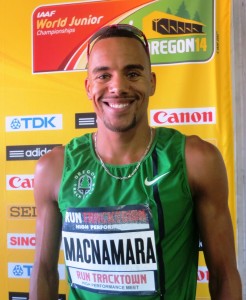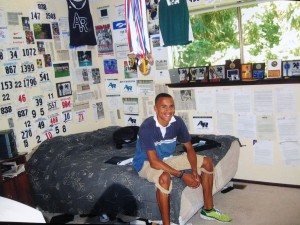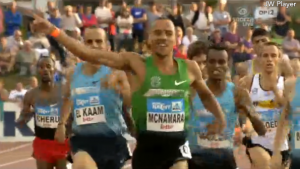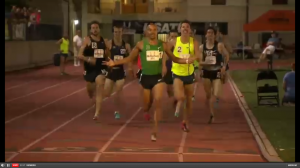The Long Road: Jordan McNamara’s Injury-Filled Path to Success
He’s suffered through 14 stress fractures and had to go to community college before running at Oregon, but Jordan McNamara’s unwavering passion for the sport has allowed him to become one of the nation’s top 1500 runners.
By Jonathan Gault
August 2014
Watch Jordan McNamara run. At the end of a race, it’s a beautiful sight, the outside of the front of his foot making just the briefest contact with the ground as his long, willowy legs propel his lean 5’10” frame forward. The smoothly pumping arms and upright form belie the effort needed to generate such speed. At his best, McNamara appears to be floating. But that form, which has carried McNamara to three USA finals in the 1500, a 3:34.00 PR and, most recently, a win at the GNC Live Well Liberty Mile on August 1 over U.S. champ Leonel Manzano, comes with a price.
“Some people get hamstring strains, some get achilles tendonitis; for me, it’s stress fractures,” says McNamara, 27. By his count, he’s up to 14 in his career, and they’ve come all over. His femur. His fibula. His metatarsus. The navicular bone in his foot.
The injuries date back to high school. His senior year at Auburn Riverside High School in Washington, McNamara went undefeated in cross country but a stress fracture in his left fibula prevented him from competing at states or Foot Lockers. That spring, McNamara was the state leader at 1600 but a staph infection two weeks before the state meet caused him to miss time and McNamara was only third. Injuries have caused him to miss important races since then — he withdrew from USAs this year when his foot began to swell — but McNamara, ever the optimist, doesn’t like to dwell on what might have been.
“Whether it’s running or a scratch in his car, a speeding ticket, he never gets angry about it,” says his close friend Doug Benson, who lives in Eugene with McNamara and McNamara’s wife Aubrea a mile southeast of Hayward Field. “He’s very methodical, trying to think about how to resolve the issue at hand.”
Passionate About The Sport From The Beginning
Through it all, McNamara’s passion for the sport remains. Many runners grow to love the sport after experiencing success. For McNamara, it was love at first sight. His first day of practice in high school, McNamara was determined to run eight miles with the varsity guys. He made it three before they dropped him, hard, and had to walk the last couple miles back to school with his coach.
Undeterred, McNamara kept running. And running. And running. He’d wake up at 5 a.m. to run before school. Instead of heading to the cafeteria during lunch, he’d go outside and tack on a few more miles. Then he’d practice with the rest of the team after school. Whenever someone asked for a partner for an extra loop, McNamara was always the first to volunteer.
“At first, my passion for the sport revolved around training,” McNamara says. “I loved to race, but I loved to train. When I’m out there and I feel strong and I feel powerful, it’s an absolutely fantastic sensation. Without getting too philosophical, it just feels good. And that encourages me to run more and that brings on more success in racing and that perpetuates the cycle.”
McNamara averaged around 80 miles per week over his last two years of high school, but that total could occasionally climb as high as 100. When he wasn’t running, he was a sponge, soaking up as much as he could about the sport to improve. He paid attention to Carl Moe, his teammate who would run 4:05 and 8:48 in high school and future World Championship qualifier Chris Lukezic, who was three years older than him and ran at crosstown Auburn High School. McNamara would scour message boards for training tips and grab copies of Runner’s World from the school library, cutting out articles and putting them up on the walls of his bedroom alongside pictures of runners such as Alan Webb, Adam Goucher, and Bernard Lagat (see photo to the right). Years later, McNamara would end up racing — and beating — Webb at the Pre Classic.
When it came time to decide on college, McNamara, who had pbs of 4:16.65 and 9:05.32 for 1600/3200 in high school, chose the University of Washington, enrolling in the fall of 2005. It was a natural fit. McNamara’s father had gone there and it was close to home, just 30 miles north on I-5. He would also be reunited with Moe, who ran for the Huskies. His career in Seattle started strongly, and he was the team’s #1 man at Pre-Nats, the top freshman in the race
Then McNamara became anemic and suddenly he began to slip down the depth chart. By the end of the season, he was the Huskies’ seventh runner, finishing way back in 224th at NCAAs. In track, though he managed to run 14:17 for 5,000 meters, McNamara was frequently injured or fatigued.
“I knew if I was going to fulfill whatever potential I had in this career, I had to get out of there,” McNamara says.
A New Start In Eugene
McNamara’s passion for running still burned brightly, and he needed to go somewhere where others felt the same. He decided to go to Eugene, Oregon, where McNamara enrolled at Lane Community College, where he was coached by Ross Krempley. Krempley was the founder of RunnerSpace.com and at that time was part of Team XO, a feeder group into the newly-started Oregon Track Club Elite under coach Frank Gagliano.
“[Ross] took me to levels I never thought I could attain,” McNamara says. “He made me take a day off every single week, he told me never to run more than 80 miles [a week] that year. I needed someone to pull me back a little bit.”
In 2007, the result was the best — and healthiest — year of McNamara’s career to that point. McNamara didn’t get hurt once and went from a 4:16 1600 runner to 3:41 in the 1500, qualifying him for that year’s U.S. Championships. That was good enough to earn him a spot at that other school in Eugene the next year.
McNamara would spend three years as a Duck and though he accomplished some great things — making the final at USAs in 2009, earning All-American honors in the 5,000 in his final collegiate race at Hayward Field — it wasn’t always easy for him. McNamara estimates he was injured 50-60 percent of the time at Oregon, which kept his mileage low, in the 60 mpw range. Still, he was always looking forward. Every night, the last thing he saw after climbing into his altitude tent for bed was a goal, three numbers written on a piece of paper on the ceiling: 3:38.
McNamara embarked on a professional career with OTC Elite following his graduation in 2010. He had earned the respect of OTC coach Mark Rowland in March of that year after defeating OTC’s Chris Thompson in a 3,000 at Hayward Field. Thompson had led much of the race but couldn’t shake McNamara, who eventually pulled away to win in 7:53.63 to Thompson’s 7:54.16. Initially, Rowland was upset because his athlete had lost to the brash upstart McNamara, who celebrated the victory in front of the home crowd.
“The manner in which he did it gave me a kind of a nasty taste in my mouth,” Rowland said.
But Rowland also saw an athlete that was eager, with a great desire to win and outstanding closing speed — McNamara had run 4:03 for his last mile and 2:26 for his last kilometer. Rowland put his ego aside and eventually McNamara joined him at OTC as the two formed a mutual respect.
McNamara’s pro career did not start out smoothly, however. He had run NCAAs on a stress fracture in his foot that spring and underwent surgery to have two pins placed in his navicular bone. He ended up missing six months of training, but on his first run back — one lap of the track at 10:00 pace — Rowland was right by his side. McNamara was also balancing a job making coffee that required him to be on his feet for 9-10 hours per day — no fun on the days when he’d run hill sessions with Nick Symmonds in the morning.
Doubles were difficult, too. Even McNamara, the man who loved to train, struggled to summon the motivation to get out there for four miles in the evening. He’d drive to parks after working 10 hours and lie in the car for 15 minutes, vainly trying to postpone the inevitable. But McNamara knew deep down that he couldn’t take any shortcuts, and he’d always get in his mileage.
The work paid off, and by the end of 2011, his first full year as a pro, McNamara had dropped his personal bests from 3:41 (1500) and 4:03 (mile) to 3:37 and 3:54. McNamara knows why.
“I owe everything to Mark Rowland,” he says.
Individualized Workouts Are Key To His SuccessThroughout his career, McNamara had always enjoyed the most success when he received individualized attention. He didn’t get enough of it at Washington, and though he says his coaches at Oregon, Vin Lananna and Andy Powell, were “phenomenal,” he was just one of six sub-4:00 milers on that team. His first breakthrough had come through an individualized program at Lane, and his time at OTC has been similar. “I don’t operate a college program,” Rowland says. “I operate an individual program within a group environment.”
|
A Look at Some of the Other Members of the Oregon Track Club EliteThough Rowland operates an individual program for each runner at OTC, he says that there are enough similarities between his runners that many of them can work out together. Since it’s the middle of the summer, many of the OTC runners are spread across the globe racing, but they’ll run together frequently during the winter and spring. Here’s a look at some of the other members of McNamara’s training group. Pat Casey Notable achievements: 2nd at 2014 U.S. Championships in 1500; ran PR of 3:35.32 in Oordegem, Belgium, on July 5 What’s he like? Casey is known for being 100 percent committed to whatever he’s doing, on or off the track. Regarded as one of the toughest guys in the group, Casey enjoys grinding out tempos and long runs even though he’s a 1500 specialist. “He’s on a mission to prove people wrong,” Rowland says. “He’s hungry. You can see that in the way he runs. He’s an aggressive man.” Ciaran O’Lionaird Notable achievements: 2011 World Championship finalist at 1500; 2013 European Indoor bronze medallist at 3,000; 1500 PR of 3:34.46 What’s he like? O’Lionaird is a versatile runner (13:33 5,000 PR) but he and McNamara are often the guys getting after it in fast track sessions. “Ciaran and Jordan are there to help it along,” Casey says. “Sometimes we can get moving — I don’t know if Coach Rowland always loves that…” The 2014 Irish champ at 1500, O’Lionaird is competing at this week’s European Championships in Zurich. Andy Wheating Notable achievements: 2008/2012 Olympian; 3:30.90 1500 PR is #2 all-time among American-born runners What’s he like? Very friendly and a bit goofy, Wheating has struggled to stay healthy over the past few years but, at 26, remains a big talent when healthy (as shown by his 3:38 win at the Portland Track Festival on June 15 in his only 2014 race). Because of his health history, Rowland is careful with Wheating’s training and he doesn’t work out in a group as much as the other OTC guys. “He’s a freak of nature where he only needs about three weeks of healthy running to do some pretty spectacular performances,” McNamara says. Hassan Mead Notable achievements: 3rd at 2014 U.S. Championships in 5,000; 13:02.80 5,000 PR from Stanford in May ranks #10 on all-time American list What’s he like? As expected given his 5,000 background, Mead dominates the group’s tempo runs and long runs. McNamara is close friends with them after spending time together on the European circuit in Leuven, Belgium, last year. “Hassan is a monster at the longer stuff,” McNamara says. “He’s one of my favorite training partners. He’s just an absolute machine. I love to hand it to him in the speed stuff and then get absolutely destroyed by him in the long tempo stuff.” Ben Blankenship Notable achievements: Finalist at 2013 U.S. Championships in 1500; 2013 Falmouth Mile champ; PRs of 3:37.03 (1500, 2013) & 7:46.55 (3,000, 2014) What’s he like? Blankenship, who was teammates with Mead at the University of Minnesota, has good speed but can also run well over longer distances, as his 7:46 3,000 from February’s New Balance Indoor Grand Prix in Boston attests. Off the track, he “likes to do his own thing and hang out with his dog,” according to McNamara. |
The first thing Rowland looks at when an athlete joins his group is the athlete’s history. Only once he figures out where an athlete is at physically and mentally — and how they reached that point — can he develop a plan to maximize the athlete’s success going forward. Rowland put McNamara through a battery of strength and mobility testing and observed how he ran on easy days and during workouts. Rowland felt that McNamara’s injuries stemmed from several factors. He saw in McNamara an athlete who needed to work on his foot plant and be stronger from the hips down in order to be effective and more resistant to injury.
Rowland also saw someone that needed to know when to push and when to hold himself back in training. McNamara’s intensity is one of his greatest strengths as a runner, but Rowland felt that his desire to push the envelope in training could sometimes lead to injuries. What Rowland and McNamara have worked on in their years together is reaching a medium that allows McNamara to be at his best during the critical parts of a season.
“We could make him injury-free, but that means training him at 50% and he’s not going to run the times he wants to run,” Rowland says. “There needs to be a strategic plan to hold back early on and at some point turn the screw.”
Easy, Easy Days
Rowland introduced a lifting program to make McNamara stronger and daily form drills to improve his biomechanics. Instead of running fast to avoid getting dropped, McNamara now runs his easy days at 6:30-7:00 pace, mostly with his housemate Benson, a 4:08 miler.
“Ultimately, all the 6:00 miles aren’t going to make 59-second pace easier; the hard track workouts will,” says McNamara.
McNamara estimates he’s been injured about 10 percent of the time with OTC, down significantly from his time at UO, and Rowland believes that his pupil has done a better job managing the intensity of his training every year he’s been with him. That’s allowed him to train consistently, which in turn has led to a steady drop in his times: McNamara ran 3:35.63 in 2012 and bettered that with a 3:34.00 in Oordegem, Belgium, last July, moving him into the top-20 all-time among Americans. He also set a PR of 3:52.42 in the mile later that month, and, when healthy, has been very competitive this season despite failing to PR. Since the beginning of May, he’s finished no lower than second in his seven races, with recent victories at the Run TrackTown High Performance Meet on July 26 in Eugene and the GNC Live Well Liberty Mile in Pittsburgh on August 1. Up next is the Falmouth Mile on Saturday, where McNamara set the meet record of 3:54.89 in 2011.
McNamara has come a long way since the navicular stress fracture that threatened to derail his career back in 2010, but with the support of Rowland plus Benson and McNamara’s wife Aubrea — “we’re the captains of Team J-Mac,” Benson says — he believes he is poised for even greater success over the next two years.
“I’ve always said I want to run 3:50 [for the mile] and I want to contend for the U.S. title,” McNamara says. “And [two weeks ago] I beat the USA champion and the USA runner-up (Pat Casey) six days before that.”
With global medallists Manzano and Matt Centrowitz, consistent veterans in Will Leer and Lopez Lomong and upstarts such as Casey and Ford Palmer, the 1500 team will be very tough to make for next year’s World Championships in Beijing and the 2016 Olympics in Rio. But if he can stay healthy, don’t be surprised to see the form of Jordan McNamara floating toward a spot on Team USA in the near future.






